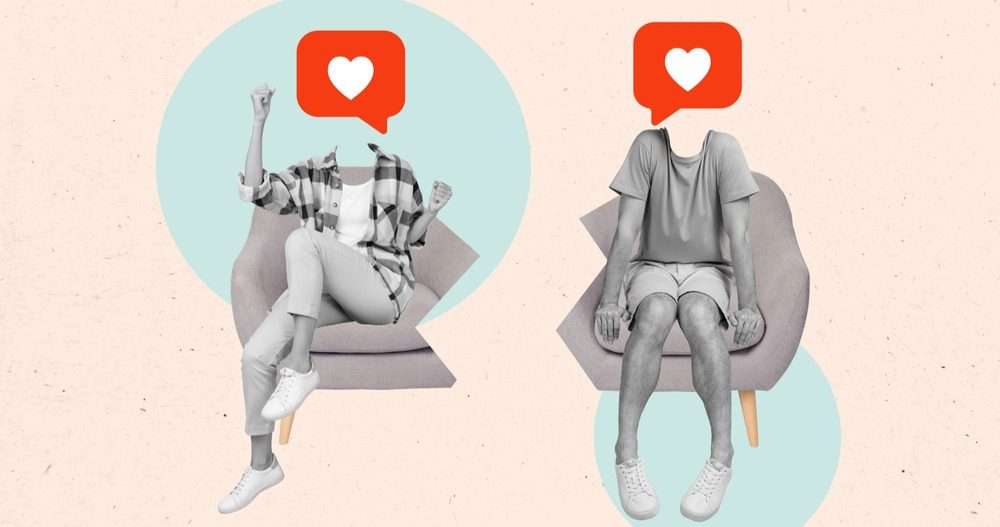 Reading Time: 7 minutes
Reading Time: 7 minutesIt’s that time of the year again. The month where we celebrate…Valentine’s Day.
Our minds are naturally starting to reflect about the state of our personal relationships.
Are my relationships healthy? Does my partner trust me? Can I rely on them to show up for me when I’m in a sticky situation?
But if you’re an entrepreneur who cares about creating a loyal base of customers, may we suggest you also spend some time asking the same questions of your business this week? Do your customers find you trustworthy? If your price and quality is somewhat similar to your competitors’ — will they still stay loyal to your brand?
You’ll be surprised to know that many of the principles we apply to fostering lasting personal relationships can also be applied to building relationships with your brand’s ideal customers. In fact, the techniques used to foster customer loyalty are a part of relationship marketing.
But what exactly is it?
In this blog, we’ll show you how relationship marketing works and how you can implement it within your business to create a loyal customer base.
What Is Relationship Marketing?
Relationship marketing is all about building and nurturing long-term personal relationships with your customers, moving beyond one-off transactions.
It is a part of customer relationship management (CRM) that aims to engage customers for a long time and build a consumer base that’s loyal to your brand.
How Does Relationship Marketing Build Customer Loyalty?
Relationship marketing focuses on:
- Understanding your customers’ needs,
- Anticipating their desires,
- Engaging with them across various channels,
- Personalizing their interactions, and
- Consistently exceeding expectations.
When you do these things consistently, you make it more pleasant to do business with you. This also makes customers feel recognized, valued, respected, and validated as individuals. They begin to personify your brand, trust it, and build a deeper emotional connection with it that feels personal. As if they almost know the values you stand for.
As customers begin to see your brand as trustworthy, your brand is more likely to become an intrinsic part of their lifestyle. Meaning, they put their trust in you time and again.
How Does Relationship Marketing Benefit Businesses?
Relationship marketing offers substantial long-term advantages to businesses by building customer loyalty.
As a result, your business will:
- Have a Competitive Edge
When you design every brand touchpoint keeping your customer at the center and make it easier to purchase from you or get a resolution for a problem with a purchase — you improve the overall experience they have with your business. Positive experiences like these with brands are memorable, and this makes this your business stand out in a sea of competitors.
An Epsilon study found that 80% of customers are more likely to purchase from a brand that offers personalized experiences. Another study also cites that 37% of customers claim they won’t purchase from a brand that offers an impersonal experience.
Positive experiences with your brand are also more likely to turn them into brand advocates. These brand ambassadors feel encouraged to make repeat purchases and refer the brand to their loved ones.
- Increase Revenue in the Long Run
Customer loyalty helps in reducing the churn rate.
As it costs significantly more to acquire a new customer over a repeat customer (5 to 6 times more), reducing churn rate is a direct way to reduce costs and improve your business’s profitability.
Loyal customers are also more likely to spend more in their entire relationship with your brand and have a 306% higher Customer lifetime value than those who do not have an emotional connection with your brand.
On average, the top 10% of loyal customers also spend twice as much per order compared with the bottom 90% of customers. They are also more likely to engage with additional products or services that your business offers.

Overview of Customer Loyalty Source: NeilPatel.com
9 Relationship Marketing Strategies For Your Business
Want to follow in Apple’s footsteps and use relationship marketing to build your own loyal customer base? Follow these tips:
1. Create Valuable Content
You can conduct market research to understand what type of content resonates best with your target audience.
Your content should:
- Address your target audience’s needs, interests, and pain points.
- Demonstrate your expertise in your domain.
- Showcase your distinctive personality.
- Communicate your brand’s authentic narrative or journey in a way that evokes emotions.
- Establish your brand’s purpose.
- Highlight your key values, experiences, and achievements.
- Engage your audience through polls, quizzes, and more.
Pro Tip: Focus on an omnichannel strategy that consistently publishes valuable content across various channel websites, blogs, social media platforms, and email newsletters.
2. Engage Them on Social Media
By creating content that your customers find useful or entertaining, you can stay memorable on social media.
Partnering with content creators who have similar values as your brand can also create more buzz for your page and help to re-engage your audience.
Here are some other ways to compel your audience to engage more with your content:
- Offer freebies or host social media competitions.
- Incorporate customer photos that feature your products as customer photos build more trust than brand photos.
- Regularly respond to their comments and engage them to keep them interested.
3. Provide Exceptional Customer Service
Just as texting your friends back on time builds a stronger relationship, communicating proactively and responding to your customers promptly can build trust. Offering good advice or help also goes a long way.
Similarly, making sure your customer service team resolves issues fairly and is empathetic can demonstrate that your brand cares about how your customers perceive your business.
According to Forbes, 86% of customers are willing to pay more for a better customer experience. PWC research also states that 42% of customers would pay more for a friendly, welcoming experience.
In other words, investing in better customer service is well worth it.
How to do it:
Imagine you run an ecommerce store and receive a customer complaint about a delayed shipment. Instead of offering a standard impersonal apology email, why not offer them a small discount for their next purchase?
This will repair the unpleasantness and also keep them coming back. You can also top it up by speeding up the shipping at no additional cost.
Like in personal relationships, a standard apology for an unpleasant experience only mitigates the situation. But when you make up for that unpleasant experience with a perk or a gesture, you earn brownie points and build loyalty.
4. Personalize Thank-You Gestures
A standard thank-you email feels too stiff for forging a personal relationship with customers. Your brand can stand out by personalizing social media posts or sending surprise gift cards to new customers.
When your customers feel appreciated, they feel an emotional connection with your brand.
They may also share your post on their personal social media, which can expose your brand to a newer audience.
5. Regularly Ask for Feedback
When you actively seek customer feedback through surveys, polls, and phone calls — you show your commitment to delivering an excellent post-purchase experience. This also creates a pleasant experience and reinforces their loyalty in your brand.
Make sure to actually implement necessary improvements based on the feedback — or else your customers may lose trust and interest in providing feedback later.
| Pro Tip:
You can win additional brownie points by informing your customers that you implemented new changes based on their feedback. This gesture can attract the attention of those who didn’t participate in the feedback process and demonstrate your dedication to prioritizing the customer experience. |
6. Implement Loyalty Programs
Launching a loyalty program to reward your customers for staying with you is a great way to keep them coming back for more purchases.
You can give out stamp cards, implement a point system that allows them to exchange points for rewards, or offer special discounts or freebies after x number of purchases.
| Pro Tip:
Loyalty programs also provide valuable data insights into customer preferences and behaviors. By analyzing this data, you can customize your offerings or services to better meet customer needs. |
7. Host Customer Events
Customer events like product launches, workshops and networking events facilitate direct interaction between your brand and customers, so you can forge a rapport that goes beyond transactional exchanges.
By bringing customers together in a shared space, you can also create a sense of belonging and camaraderie among attendees. And creating a community around your brand is one of the best ways to retain loyal customers.
Such events also offer an opportunity for experiential marketing, where customers can interact with your products or services in a hands-on way. It allows customers to see and experience the value of your offerings firsthand, leading to increased brand affinity.
Take advantage of the event to also gather some valuable insights by asking for in-person feedback and suggestions. This is different from asking for feedback online as you are more likely to get immediate and unfiltered responses.
8. Launch Customer Advocacy Programs
Launching customer advocacy or brand advocacy programs rewards customers to do word-of-mouth marketing for your brand or refer others to your business.
Here’s how you can organize them:
- Define clear objectives for the program, i.e. increasing brand awareness or driving referrals.
- Establish a rewards system, i.e. discounts, exclusive perks, or recognition. For example, you can offer discounts on future purchases or free samples of new products.
- Use various marketing channels, including email newsletters, social media platforms, and in-store signage, to promote the program.
| Note:
While loyalty programs and customer advocacy aim to engage and reward existing customers, they serve different purposes. A loyalty program incentivizes repeat purchases and customer retention. A customer advocacy program taps into the enthusiasm and loyalty of existing customers to generate buzz, attract new customers, and enhance brand credibility through authentic customer testimonials. |
9. Launch Email Marketing Campaigns.
Emails can be the most personalized form of marketing because you can customize the content, timing, and frequency of your emails based on your specific marketing objectives and target audience preferences.
Here’s how you can personalize your emails:
- Create a series of emails for different purposes. This includes welcome emails for new customers, newsletters to educate picky buyers, exclusive discount emails for existing customers, or surveys/polls for all customers. You can also share updates, make announcements, and more.
- Segment your email lists based on customer demographics, purchase history, or preferences. You can deliver targeted messages to encourage sign ups or drive them to your website.
Here’s how personalized emails can help your business:

Benefits of Personalization In Email Marketing
Source: Recommend.pro
How Vizion Helps Brands Build Customer Loyalty With Effective Relationship Marketing?
At Vizion, we are adept at guiding businesses through the complexities of relationship marketing with tailored strategies that resonate with their target audience. With us, you gain access to professional services that prioritize authenticity, relevance, and measurable results.
It’s time to LOVE your digital marketing agency! Enquire with us to get started.
FAQs
Is customer acquisition less important than customer retention now?
Customer acquisition remains crucial for businesses, especially new or expanding ones. However, considering the cost implications, a balanced approach with a stronger focus on customer retention can be more beneficial in the long run.
How can small businesses implement effective customer retention strategies?
The approaches for relationship marketing remain the same, regardless of the business size. Small businesses can also build a loyal customer base with exceptional customer service, implementing loyalty programs, and encouraging word-of-mouth referrals.
What are some common mistakes in customer retention strategies?
Common mistakes in customer retention strategies include overlooking the importance of customer feedback, neglecting personalized experiences, and inconsistent communication.




